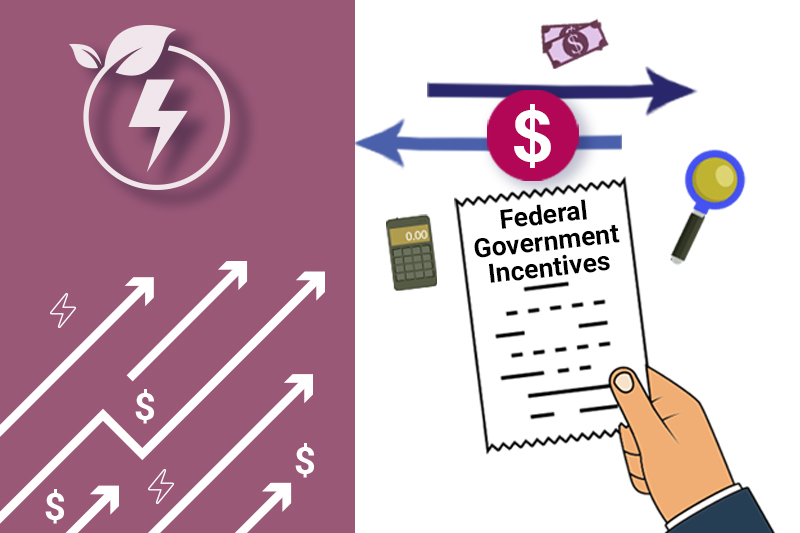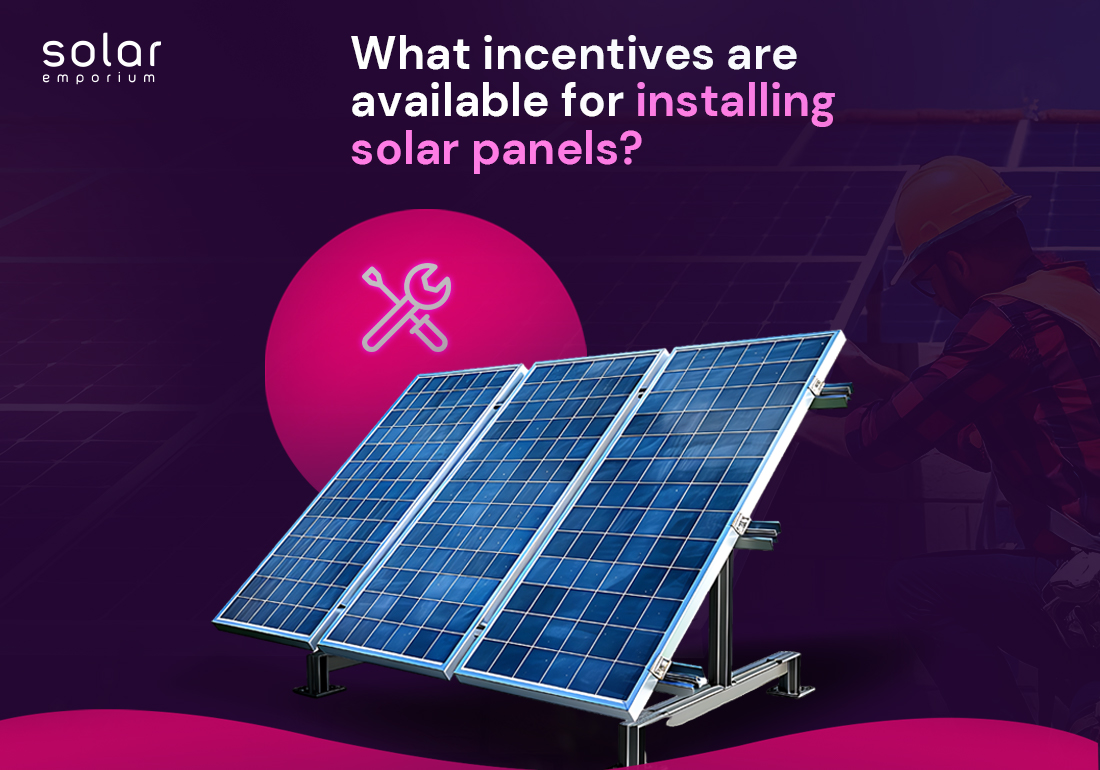Living under Australia’s abundant sunshine, it’s no wonder why most people are eager to harness solar energy to fulfill their energy needs. It reduces the country’s carbon footprint, ensures energy independence, and brings potential savings by lowering energy bills.
However, when considering switching to solar energy, one sudden thing might hold you back: the associated high installation cost of solar panels.
Fortunately, the Australian government offers many solar incentives and rebates to offset this initial cost and encourage more people to adopt green and sustainable lifestyles.
Are you curious about what incentives are available for installing solar panels?
In this blog, we will explore various incentives, including the Federal Investment Tax Credit (ITC), state incentives, and local rebates.
So, let’s transform your financial burden into a meaningful long-term investment by installing solar energy with available incentives.
Empowering Your Solar Journey: Incentives and Rebates in Australia
What are Solar Incentives?
Solar Incentives and rebates in Australia are mainly designed to promote clean energy production. These financial programs increase the adoption of solar energy and reduce the higher upfront cost of installing solar panels.
With the excessive use of fossil fuels and environmental pollution, these solar incentives, government grants, and funding are also helping to lower carbon emissions and foster a sustainable future together.
Incentives and rebates on solar panels also make solar energy widely accessible. People from diverse economic backgrounds can now access this clean energy at minimal cost.
So, whether you are a new or existing solar consumer, it is time to grab this amazing opportunity and enjoy the full benefits of solar power systems without spending much!
How Solar Incentive Works?
Knowing how solar incentives work is crucial for many reasons. They offset the higher installation cost and ensure many environmental and monetary benefits. They lower the pay and even allow you to earn by selling excess electricity back to the grid.
Together, these different incentives and rebates enhance Solar’s overall financial appeal, making it an economically viable option in the renewable energy world.
In addition to your local government, many utility companies, manufacturers and installers, and equipment inventors offer various solar incentives in Australia.
Therefore, before installing solar, you should thoroughly explore and understand these available incentives. This will help you make a more informed choice about solar investment and maximize your energy savings.
Let’s hover over the next segment to obtain a detailed understanding of different incentives and rebates.
Australia’s Best Solar Incentives and Rebates for Installing Solar Panels in 2024

Federal Government Incentives: The Renewable Energy Target (RET)
Renewable Energy Target (RET) is one of the most common schemes offered by the federal government of Australia.
It works under two separate divisions, LRET and SRES, where the government ensures that a significant portion of Australia’s electricity comes from renewable sources.
| Large-scale Renewable Energy Target (LRET) | Small-scale Renewable Energy Scheme (SRES) |
| In this Australian government initiative, people are encouraged to use renewable sources for electricity generation. This targeted program works by creating LGCs and selling them to adjust a portion of your solar panel installation cost. | In residential solar settings, a small-scale Renewable energy scheme works best. By receiving and selling small-scale technology certificates (STCs), homeowners can offset the installation cost of solar PV systems. |
The small-scale technology certificates (STCs) or Renewable Energy Certificates (RECs) cover a portion of the total cost of solar panel installation. These certificates work as a financial incentive where the energy you save is denoted accurately.
You can also trade or sell these certificates by generating solar power and receive additional income from these programs.
Federal Investment Tax Credit (ITC)
The Federal Investment Tax Credit (ITC) allows you to receive a 30% credit on your solar system. This credit is deducted from your federal taxes and is valid until the end of 2030.
Australian State-Based Incentives for Solar Panels
In Australia, the states offer additional tax credits, different government rebates, state-based incentives, or grants depending on specific state laws and regulations.
However, in the following part, we’ve shared some of the state-based incentives or local programs that might help you make a decision about installing solar panels.
Queensland
Living in Queensland, you can get up to $26,00 off on a 6.6kW PV solar system installation. Their primary focus is not only solar panels but also battery storage systems.
Besides all these, the Queensland Solar for Schools program is also a great initiative that targets educational institutes across Queensland in Australia. The program promotes the use of renewable energy where it educates students about sustainability and energy efficiency.
New South Wales
In New South Wales, interest-free loans are offered for solar panel installations. You can check your eligibility and apply for any available schemes.
They also provide several grants for installing solar systems for low-income households. The state ensures up to 33% of installation payment for solar panels, so the higher upfront cost is no longer a barrier.
Victoria
Victorian Solar Homes Program offers significant rebates for solar panel installations and battery systems. Homeowners can receive up to $1400 off the cost of solar panels.
In addition to the rebates, they allow interest-free loans, which easily cover the residents’ solar panel upfront costs.
South Australia
Besides panel installation, the solar panel rebate program in South Australia offers around $2000 for incorporating solar battery systems.
These incentives encourage residents to rely more on solar energy, embrace this clean energy source, and enjoy a continuous power supply.
Western Australia
Have you ever heard about the term solar bulk buying? In Western Australia, solar bulk buying programs are introduced, and these schemes reduce the cost to a certain amount.
They offer solar subsidies in 3 packages:
- 1.5KW to 2.5KW system cost around $1500
- 3KW to 4KW system, for approximately $2700
- 5KW to 6KW system cost nearly around $4000
They also promote Feed-in Tariff Programs where Homeowners can earn credits for the excess energy they send back to the grid.
Tasmania
Like other state programs, Tasmanians can now benefit from solar incentives and tariffs. To install a 5KW solar panel system in Tasmania, you can receive a subsidy of around $1875.
Australian Capital Territory (ACT)
Under the Sustainable Household Scheme, ATC gives zero-interest loans in between $2,000 and $15,000. After passing the eligibility test, households can select from solar equipment such as solar panels, battery storage systems, heating and cooling systems, and more.
The repayment period is also extended; you can pay within ten years. This makes the installation process hassle-free and manageable for the local community.
Northern Territory (NT)
According to the Northern Territory’s Home and Business Battery Scheme, you can get an incentive of nearly $2,554 for 5kW and a $5,147 rebate for a 10kW PV system.
The scheme focuses on reducing reliance on fossil fuels and supporting the solar revolution.

Alternative Financing Options for Solar Panels in Australia
- Many companies offer loans specifically for solar installations, but you have to pay competitive interest rates to get that.
- Individuals can lease the system or pay for the power it generates through leases and power purchase agreements (PPAs). This allows them to enjoy the full benefits of solar without buying it with little to no upfront costs.
- Some municipalities offer local incentives or rebate programs, such as property tax exemptions or additional rebates.
Unlocking the Benefits of Incentives and Rebates on Solar Panel Installation
Incentives and rebates for solar panel installation not only help Australians save upfront costs but also ensure numerous other benefits. They significantly impact homeowners and the wider community and illuminate their path towards a sustainable future.
Here, we have jotted down all the key advantages of incentives available for solar installation in Australia in 2024. So, let’s have a closer look:
Solar Brings Financial Savings
- These available incentives significantly make solar more accessible to a wide range of people by reducing the upfront cost.
- Installing solar panels is a long-term investment that saves money throughout the system’s lifespan.
Provide Energy Security and Increase Property Value
- A large number of incentives means more and more people are interested in solar installations, leading to a more resilient energy system.
- It reduces dependency on centralized grid power and increases property value with all the appealing features of energy-efficient homes.
Incentives Increase the Solar Adoption Rate
- As you don’t have to pay a high amount at a time with these government solar rebates and incentive programs, they encourage people to install solar panels to meet their energy needs.
- These financing options can stimulate market growth, create more jobs, and make the renewable energy sector economically viable.
Result in Environmental Benefits
- Want to lower your carbon footprint and maintain a healthy lifestyle?
Increase the adoption of solar panels. Solar is a clean energy source that reduces the use of fossil fuels, ensures better air quality, and helps mitigate climate change issues.
Overall, solar panel’s contribution to sustainable energy goals is unnoticeable.
Create Educational Opportunities
- Solar Incentives programs are an excellent way to raise awareness in the renewable energy sector. It helps people understand the importance of sustainable living while enhancing community resilience and energy security.
Technological Advancements and Future Trends
- Any financial support, such as incentives, rebates, or other tax credit programs, can encourage innovation and improvements in solar technology.
- This often leads to outstanding outcomes, offering cost-effective systems that come with financial flexibility and are more efficient.

Top Strategies to Maximize Solar Incentives in Australia
Did you know you can maximize the amount for incentives by following a few easy steps? Perhaps you are wondering how!
Well, let’s dig out the best ways to optimize your solar tax credits and incentives in the following part:
Performing thorough research:
In Australia, incentives and other rebates or tax credit programs change frequently. So, before installing the solar panel, ensure you have updated information and understand the latest incentives.
You can go through the Australian government portals, local councils, or energy control authorities for the most updated and reliable information.
Stay well-connected with the professionals:
It’s always wise to consult and maintain a proper connection with your area’s best and most renowned solar installers. Experts can handle all possible hassles and paperwork more efficiently and quickly provide the best, optimal solutions.
Estimate your energy requirement:
Do you know how to calculate the electrical load for home appliances? If not, it’s high time to learn. Proper estimation can save you money on electric bills and help you understand your energy requirements.
Suppose you extend the system by adding a 10 KW solar battery storage in cases where only the panels are insufficient. This helps to achieve long-term savings and gives you a reliable power source for more than 10 to 12 hours.
Be aware of the multiple solar quotes:
If you want to find the best deal on solar installation, try getting quotes from multiple installers. By sticking to one specific provider, you can overlook the facilities offered by other companies.
However, you can contact Solar Emporium for any solar needs. We offer the best deals and solar packages in Australia.
So what are you waiting for? Join us today and get the free solar quotes!







